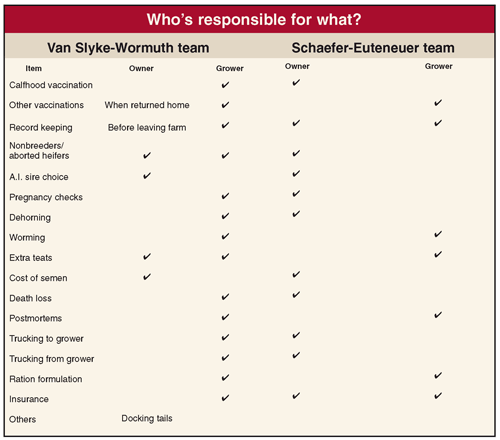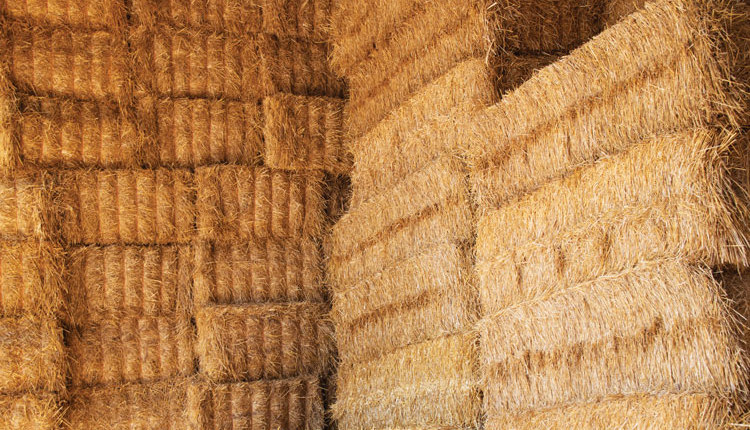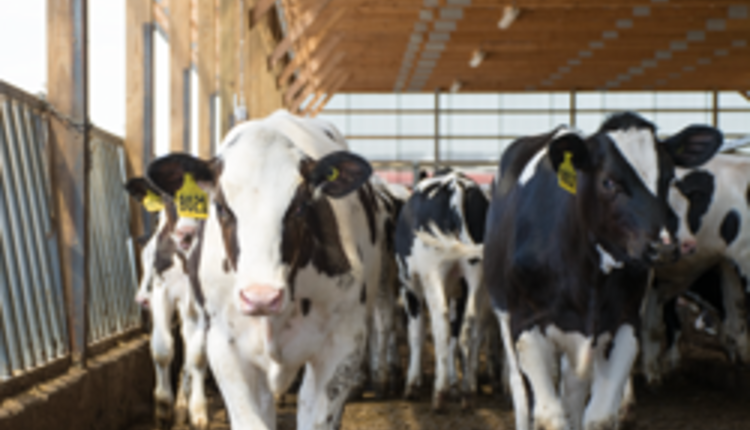
Their reasons to enter the custom heifer raising business are different, but results are the same. A new business relationship, convenience, and highly productive cows were developed from these heifer-raising relationships. Hobby Hill Farm, a heifer raiser, and Evergreen Acres, their dairy client, in central Minnesota began working together because of their close proximity and the changing needs of both. Van Slyke's Dairy and CY Heifer Farm aren't neighbors, but CY's bio-secure and pathogen-free facility, along with competitive rates, brought the Van Slyke heifers to CY Heifer Farm in western New York under the care of heifer manager Jeanne Wormuth.
Raising heifers accounts for about 20 percent of total operating costs on dairy operations. It's an investment in the future that doesn't return money until heifers calve. Custom-raising of heifers, which is more common as herds grow in size, offers producers the opportunity to leave heifer care in the hands of those who focus solely on it. For both of our Round Table dairies, custom-raising heifers gave them the opportunity to grow their milking herd without adding housing for replacements. In addition, off-site heifer raising decreases heifer exposure to adult cow diseases like Johne's.
Many heifer-raising operations in the U.S. do not exclusively raise heifers as Hobby Hill Farm does. This means that many custom-raised heifers comingle with those of several other herds - which becomes a risk for disease introduction from other herds. CY Heifer Farm, as well as many other custom raisers, answers this challenge by having an extensive health and biosecurity protocol for all heifers on the farm, as well as staff and visitors.
The USDA's National Animal Health Monitoring System (NAHMS) conducted research in 2007 regarding off-site heifer raising on U.S. dairy operations. They found that about one in 10 operations raised at least some of their heifers off-site. For farms milking more than 500, 46 percent of operations raised heifers off-site of the main dairy. That number is drastically smaller for herds under 100 cows in which less than 5 percent of all herds raise heifers off-site.
The age at which heifers are sent off-farm varies, but NAHMS research says that slightly more than half are sent prior to weaning, 41 percent are sent just after weaning, and nearly 6 percent primarily sent bred heifers off-site to be raised.
Ultimately, the choice is yours, and the goals of both the dairy and heifer raiser must be examined before entering in a partnership. Both of these teams who participated in our Round Table discussion agree that honesty and good, timely communication are essential keys to successful custom heifer raising. Read further to find out more about these successful teams who are raising the future herd.
What is your working relationship?
Euteneuer (grower): We started with Keith in 1995. At that time, we had a contract. Over the years, we built up trust. Now we have a verbal contract. We make out a bill in the beginning of the month, and payment is due at the end of that month. We go by a per-day charge. In this part of the country, that's what people do, and it's simple.
Schaefer (dairyman): We've worked with the Euteneuers at Hobby Hill for 13 years. The first six years we had a written agreement. As of now, we have just a verbal. Vaccinations and breeding protocols were details covered in the written agreement. We handle compensation per day. Both parties agreed on per day.
Wormuth (grower): We have worked with Van Slykes for 10 years. We do have a written contract. Key details are security agreement; price structure; breeding guidelines; expectation on our side; program; growth goals; accidents; death; what happens. Compensation is on a per-day charge.
We chose this because of the different contracts that we deal with. There is movement of animals in and out of all ages. It makes it a lot easier to invoice and gives the customers a feel for the costs at different age levels.
Van Slyke (dairyman): Since the heifer farm started, our heifers were the first ones in the facility. Compensation is per-day charge.
Growers - What age animals do you raise, and how many?
Euteneuer: Right now, we have 10 pens for 8 weeks to 18 weeks, three pens with open fronts that house 18 weeks to 7 months, and seven pens with dry lots and mound lots for 7 months to 16 months. We then have two pens in a free stall barn for 16 months to 22 months. We have around 800 head total.
Wormuth: We raise from babies to finish - 6 to 8 weeks due to freshen. Number of heifers last year was 4,000.
Dairymen - How many of your dairy's heifers are raised by your custom grower?
Schaefer: About 80 percent of our heifers are raised by Hobby Hill; the other 20 percent are raised by another heifer raiser. They are 3 months of age when taken to the heifer raiser, and we bring them back about 12 weeks before they calve. We raise the baby calves up to 3 months of age, and we choose to raise them to that point because the first six years they were custom raised, and we weren't satisfied.
Van Slyke: 100 percent of our heifers are raised by CY. Age when they go is 1 to 7 days. Heifers are brought back to our farm 60 days before freshening.
Growers - What prompted you to go into the business of raising heifers for others?
Euteneuer: I was a DHIA supervisor in the fall of 1990 when we bought this farm. We had hogs, steers, and Holstein heifers. The hours got to be too much, so we had to go bigger or cut back. I was testing by Keith, and we got talking. He needed someone to raise his heifers ages 8 weeks and up. So, we built the calf barn.
Wormuth: Back 10 years ago there seemed like a need for custom heifer growers. It was one area that was lacking. We started in 1998, and the first calf entered on December 2. We went from all in and all out to contracts of all kinds. We've really gotten better at understanding the goals and feed need to get to the finish line and gained experience with different health issues through the years. We have promoted our business by running ads, giving tours, and using our consultants (vet, breeders, and so forth) to help look for new clients.
Dairymen - Why do you choose to have your heifers custom raised?
Schaefer: Back in 1995, we didn't have the facilities to raise heifers. Our dairy has expanded from 60 to 1,500 cows in the last 13 years, since we've had our heifers custom raised. He lives just two miles from the dairy so he's close, and we're able to keep a close eye on the heifers so we know what's going on at all times. Also, there's less trucking time of the heifers.
Van Slyke: Labor issues led us to have them custom raised, and they have been custom raised 12 years now. Our dairy enterprise has grown by filling our facility with dry cows instead of heifers, allowing us to milk 300 more cows. This heifer grower offered a bio-secure, pathogen-free facility, and prices were very comparable to other custom raisers. They also provided transportation to and from our farm.
Growers - Describe your facilities.
Euteneuer (grower): Our calf barn has 10 pens, eight of them 16 feet by 32 feet and two of them 20 feet by 32 feet. It's a pole barn with curtain sidewalls and an insulated roof with hay and grain and machinery storage on one half. Three pens have an open front with curtain sidewalls. We also have open dirt lots, depending on age. Lastly, we have a free stall barn with two groups, 84 stalls per group. Just our family runs our heifer farm and does all of the labor.
Wormuth: Babies are in group housing with automatic feeders. That holds 300 calves with 2-1/2 employees - 120 animals per employee. Weaned calves are on a bedded pack, 8 to 10 per group, 250 animals - one employee (2 months to 6 months).
For those 3 months and up, we have free stalls with a neck rail until the breeding barn. The breeding barn has head locks. Four employees (about 2,350 animals) work in this area with 588 animals per employee.
Dairymen - How were your heifers raised previously?
Schaefer: When we milked 60 cows, we had just a few heifers, so they were raised in a slatted barn. Now, it isn't being used at all. I was doing the labor myself for the few heifers we had at that time.
Van Slyke: Heifers were raised in calf huts and in a free stall barn. The free stall barn is now used to house our dry cows. It took two people to take care of calves and heifers; now those people spend more time with cows at freshening time by giving the calves and cows more attention and care.
Growers - How do you keep track of heifers?
Euteneuer: All are on computer. They have two ear tags in and a national ID tag. Two tags are a must for us. The button tag, I think, is the best.
Wormuth: We use Dairy Comp 305 to track animals. We have a working number in their ears for Dairy Comp and source farm ID. Everyone has a USDA metal tag. In case an ear tag falls out, we have a backup. It never fails that ear tags fall out.
Dairymen - What system do you use to identify your heifers?
Schaefer: All heifers are double ear tagged before they leave the dairy. We use two tags and the RFID tag.
Van Slyke: All heifers have a metal ear tag from the state and a yellow ear tag in each ear with the number they were given at birth. Heifers are tagged with metal ear tag at birth, and yellow ear tags are put in before they come back to the farm.
Growers - What requirements do you have for the client's heifers?
Euteneuer: When we started raising small calves, Keith took them from the hut to my place. At that time, we vaccinated and dehorned here. Now, Keith vaccinates and dehorns, then groups them and brings them. If a calf is small or not healthy, it stays back. Once they come, they are my expense except for hernias.
Wormuth: We recommend the source farm vaccinates with Scourguard and J5 for the cows. We test for total protein, and farmers get feedback quickly. Calves need a USDA metal tag and a button tag with their ID or ear tags in when they arrive. Farms that are far away and pick up once a week draw the blood for us at 24 to 36 hours of the calves age. Those farms also give a TSV-2 (bovine rhinotracheitis-parainfluenza3) and some vitamins. We provide the vitamins to the farmer. We take care of trucking and everything else.
Dairymen - What special needs are taken care of before your calves leave the dairy? What special needs do you take care of upon their return?
Schaefer: We raise the calves to 3 months of age. We take care of colostrum which 1 gallon is fed in the first hour of birth. They are also double ear tagged then. They are vaccinated before they are moved out of the calf hut. Ten days after they leave the hut, they are revaccinated and dehorned. There is nothing done to the heifers until they return to Evergreen Acres where they are put under Evergreen Acres protocol.
Van Slyke: Each heifer has her colostrum feeding and metal ear tag before leaving our farm. When returning home, they need some vaccinations before freshening.
Growers: - What about biosecurity?
Euteneuer: We have one herd, so the heifers are not a problem. Young calves are brought to the calf barn and put in pens of 10 in the same building, and each pen is moved down as new ones come in. Nutritionist, vets, and others entering the farm are watched for issues.
Wormuth: All calves entering the facility are tested for BVD. Older ones need to be tested and have a negative result before coming. They also need to be vaccinated with a modified-live vaccine (two doses). If we have an empty pen, they are moved there first and moved into their age after a week or two.
Dairymen - How do you handle biosecurity issues?
Schaefer: We just keep everything as clean as possible, and Hobby Hill only raises Evergreen Acres' heifers. They're brought back to the dry cow farm, and they start their 12-week shots. Our heifers aren't isolated. We administer J5, Salmonella, and Scourguard vaccinations.
Van Slyke: When heifers return, they are isolated in their own group with other heifers that have already come back from CY. They stay in this group until three weeks before freshening. They are then moved to a bedded pack area and get vaccinated. When they make this move, they co-mingle with cows already on the farm that will be freshening in the same time frame.
Growers - How do you ensure adequate growth rates?
Euteneuer: At one time, we weighed different groups. We have height markers in all of the pens.
Wormuth: We have heifers calve in from 21 to 24 months. It really varies by client. Most breed at 13 months, but I have 12 months to 14 months. We weigh the animal about eight times during her stay with us. There are goals set in place at each age level. We know what we have to make at each stage.
Dairymen - How do you ensure adequate growth rates?
Schaefer: We use height tapes at different ages at the heifer raiser. Being Hobby Hill is only two miles away, it is easy to inspect them. As of right now, calving age is averaging 23 months.
Van Slyke: We work very closely with Jeanne at CY, who sends us a report monthly of any heifers that don't meet adequate height and weight. At this time, we make the decision to sell the animal or not.
Growers - What are the keys to maintaining a successful relationship with your dairy producer?
Euteneuer: Be honest. If you do something wrong, tell him the truth. He can deal with that. We thought about Dairy Comp to match Keith's computer. It was more than we needed, so we went with Heifer Pro. Then, we gave him a printout. Now, Keith does the heat and breeding, so he keeps the records.
Wormuth: The key is timely communication. Some farms I phone, and others are by e-mail. It usually is a weekly connection. Some dairies want weekly summaries, and that makes them feel more connected. Each farm is a little different. You have to figure out what works for them. We use Dairy Comp 305, and most of our source farms do, also. We are electronically sending breeding information weekly. I also send paper copies at the end of each month with the invoices.
Dairymen - What have been the keys to maintaining a successful relationship?
Schaefer: Being Hobby Hill is only two miles away, it's easy to communicate in person at least once a week. Hobby Hill has a computer program; all the information is entered and then given back to the dairy upon the heifers' return.
Van Slyke: We are in contact with each other at least once a week. Any concerns we have at all are worked out immediately. All heifer information is mailed to us every month, then entered into our computer. We are just starting a new method of downloading the information from CY every week.

0912_746











